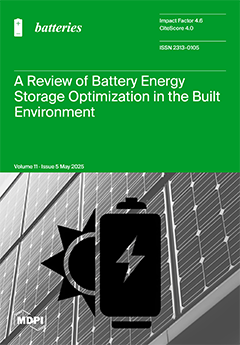Zeolite Battery Research Africa (ZEBRA) batteries (Na-NiCl
2 solid electrolyte batteries, SEBs) have commercial applications in energy storage due to their low costs and recyclability, long lifetime, and high safety. In commercial ZEBRA batteries, Ni electrode and beta’’-alumina solid electrolyte (BASE) have a
[...] Read more.
Zeolite Battery Research Africa (ZEBRA) batteries (Na-NiCl
2 solid electrolyte batteries, SEBs) have commercial applications in energy storage due to their low costs and recyclability, long lifetime, and high safety. In commercial ZEBRA batteries, Ni electrode and beta’’-alumina solid electrolyte (BASE) have a more than 70% share of the overall cell material costs. Na-ZnCl
2 all-liquid batteries (ALBs), which replace Ni with abundant and low-cost Zn and BASE electrolyte with molten salt electrolyte, could reduce costs and provide a longer lifetime and higher safety, making their application in grid storage promising. However, compared to SEBs, ALBs are in an early development stage, particularly for their molten salt electrolytes, which have a significant effect on the battery performance. Physical and chemical properties of the salt electrolyte like melting temperatures and solubilities of electrode materials (i.e., Na and Zn metal) are vital for the molten salt electrolyte selection and battery cell design and optimization. In this work, the binary and ternary phase diagrams of salt mixtures containing NaCl, CaCl
2, BaCl
2, SrCl
2, and KCl, obtained via FactSage simulation and DSC measurements, as well as the solubilities of electrode materials (Na and Zn metals), are presented and used for the selection of the molten salt electrolyte. Moreover, various criteria, considered for the selection of the molten salt electrolyte, include high electromotive force (EMF) for suitable electrochemical properties, low melting temperature for large charge/discharge range, low solubilities of electrode materials for low self-discharge, low material costs, and high material abundance for easy scale-up. Based on these criteria, the NaCl-CaCl
2-BaCl
2 and NaCl-SrCl
2-KCl salt mixtures are selected as the two most promising ALB molten salt electrolytes and suggested to be tested in the ALB demonstrators currently under development.
Full article





